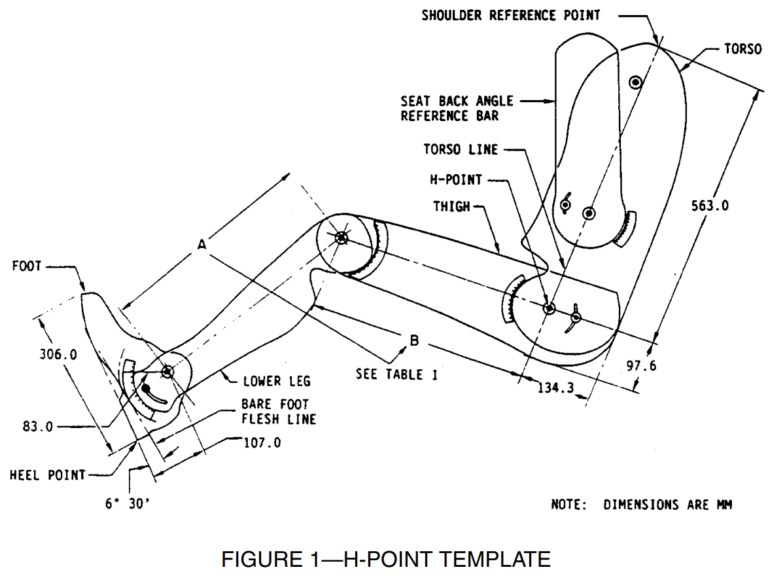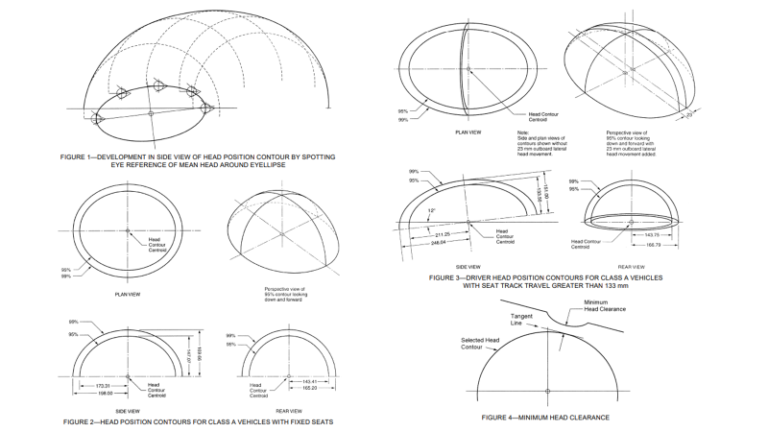Measured Vehicle Inertial Parameters (SAE 1999-01-1336)
The following is a summary of SAE1999-01-1336 Measured Vehicle Inertial Parameters. To view the original document see the attached PDF.
SAE1999-01-1336 Measured Vehicle Inertial Parameters – Abstract
The paper presents an updated listing of the National Highway Traffic Safety Administration’s (NHTSA) Light Vehicle Inertial Parameter Database. It includes vehicle inertial parameters measured up until September 1992, as well as 82 new entries collected since then, bringing the total to 496 entries. The data includes complete vehicle inertial parameters, tilt table results, or both for various vehicles. The paper also discusses the accuracy of these measurements and provides selected graphs for some 1998 model-year vehicles.
Introduction
The introduction emphasizes the importance of knowing a vehicle’s inertial parameters for safety research and accident reconstruction. While basic measurements like wheelbase and track width can be easily obtained, accurate measurement of critical parameters such as center of gravity height and moments of inertia requires specialized equipment. The paper discusses the use of NHTSA’s Inertial Parameter Measurement Device (IPMD) and Tilt Table for measurements before September 1992, and the use of S.E.A., Inc.’s Vehicle Inertia Measurement Facility (VIMF) and Tilt Table for measurements from September 1996 to November 1998. No new data was added to the database between September 1992 and September 1996.
Light Vehicle Inertial Parameters Database
Due to the challenges of measuring certain inertial parameters like center of gravity height and moments of inertia, NHTSA created a database to store these values. The original paper aimed to make this information accessible to others, and the current paper serves the same purpose. The update is driven by NHTSA’s renewed focus on light vehicle rollover research, during which they collected substantial inertia and tilt table data for recent vehicles. The paper includes complete test results for 12 vehicles from rollover research and 32 vehicles from the 1998 model year, with tests conducted under various loading conditions. It also covers data from other vehicles tested by NHTSA in the past two years as part of their crash avoidance research.
ACCURACY OF THE INERTIA MEASUREMENTS
The column “IPMD Ver.” in the Light Vehicle Inertial Parameter Database identifies the specific version or model of the test device used for a given test. NHTSA’s Inertial Parameter Measurement Device (IPMD) has undergone several upgrades since 1987 to improve accuracy. A “1” in this column indicates the original IPMD configuration was used, while a “2” shows the IPMD had one major improvement, and so on. “VIMF” denotes that measurements were taken using S.E.A., Inc.’s Vehicle Inertia Measurement Facility, and “TT” indicates the test was performed only on the Tilt Table. Table 1 in the paper summarizes the measurement error bounds for center of gravity (C.G.) height for the VIMF and various IPMD configurations.

Accuracy of pitch and roll moment of inertia measurements
The accuracy of pitch and roll moment of inertia measurements for the IPMD and VIMF is closely linked to the accuracy of center of gravity (C.G.) height measurements. For the IPMD Version 5, the error bounds for pitch, roll, and yaw inertia measurements are around 3%. Older IPMD versions have higher errors for pitch and roll, while yaw inertia errors range between 3-5%. The VIMF has quoted error bounds of 1% for pitch and yaw inertia, 2% for roll inertia, and 6.8 kg-m² for roll/yaw product of inertia.
The paper also provides an overview of the inertia measurement results for 32 vehicles, referred to as “1998 NCAP” vehicles, tested by NHTSA. These vehicles include passenger cars, vans, light trucks, and sport utility vehicles, covering a range of classes and weights from approximately 1050 to 2700 kg. Measurements were taken with only a driver and, for 20 vehicles, also at their Gross Vehicle Weight Rating (GVWR). The results include calculations for Critical Sliding Velocity (CSV) and the ratio of the distance from the C.G. to the front wheels over the vehicle wheelbase (a/L).



The Static Stability Factor (SSF) values for the driver-only loading condition are plotted against vehicle mass in Figure 1. Passenger cars, as a class, show the highest SSF values, while SUVs have the lowest. However, some SUV models have SSF values similar to those of light trucks and vans. The Critical Sliding Velocity (CSV) values, although not provided in the database, are calculated and shown in Figure 2. Similar to SSF, passenger cars exhibit the highest CSV values, while SUVs have the lowest, with some light trucks displaying CSV values comparable to the lower end of the SUV range.
In Figure 3, SSF is plotted against CSV for the driver-only configuration. As expected from the previous figures, passenger cars cluster in the upper right, indicating higher stability, while most SUVs are in the lower left, though some SUVs overlap with light trucks and vans. A linear fit of this data yields a slope of 0.070 and an r² value of 0.91, indicating a strong correlation between SSF and CSV. Figure 4 plots the ratio of center of gravity (C.G.) height to roof height against vehicle mass, showing no clear distinction between vehicle classes or mass. However, one SUV exhibited a relatively high ratio, while the rest of the vehicles had similar values across all classes.
Figures 5a and 5b illustrate the impact of loading to Gross Vehicle Weight Rating (GVWR) on SSF, with passenger cars and vans shown in Figure 5a, and light trucks and SUVs in Figure 5b. Loading had little effect on passenger car SSF values, with one vehicle’s SSF unchanged and another’s even increasing when fully loaded. In contrast, SSF values for light trucks, vans, and SUVs decreased when loaded to GVWR, with reductions ranging from 0.02 to 0.15.
Figures 6a and 6b plot the ratio of the distance from the C.G. to the front wheels over the vehicle wheelbase (a/L) as a function of mass for both driver-only and GVWR conditions. The a/L ratio increases with GVWR loading, indicating a rearward shift in the longitudinal C.G. location. Passenger cars had the lowest a/L ratios in both conditions, with one van and one truck showing values similar to passenger cars.
Figures 7 through 10 present normalized roll, pitch, yaw, and roll/yaw inertia values, respectively, as functions of vehicle mass for the driver-only condition. Roll inertia was normalized by vehicle mass times half the track width squared, pitch and yaw inertias by vehicle mass times half the wheelbase squared, and the roll/yaw product of inertia by vehicle mass times track width times wheelbase divided by four. These normalizations provide general value ranges for different vehicle classes.
Vans exhibit the highest normalized roll inertia as a class, while trucks in the driver-only condition have the smallest normalized pitch and yaw inertias. Additionally, trucks in this condition show negative roll/yaw products of inertia due to their front-heavy and rear-light mass distribution when unladen, unlike the other vehicle classes, which have positive values.

Overview of NHTSA Rollover Test Vehicles
The Tilt Table Ratio (TTR), Critical Sliding Velocity (CSV), and Static Stability Factor (SSF) values for 12 NHTSA rollover test vehicles are presented in Table 4 and illustrated in Figure 11. Among these vehicles, seven are also listed in Table 2. All are 1998 models except for the 1997 Ford Ranger, which is a four-wheel-drive vehicle.
The vehicles are arranged by class and then by mass, with the lightest vehicles listed first. All three ratios—TTR, CSV, and SSF—show a consistent trend across the vehicles. A linear regression analysis of SSF versus TTR yields a slope of 1.09 and an r² value of 0.90, while the SSF versus CSV regression has an r² value of 0.85, similar to the earlier finding of 0.90 for all 32 vehicles.
The Inertial Parameters Database is divided into two parts: Part 1 includes vehicle descriptions, configuration data, wheelbase, track width, roof height, weight, and test comments. Part 2 contains vehicle descriptions, configuration data, center of gravity (C.G.) position, moments of inertia, roll/yaw products of inertia, tilt table ratio, and static stability factor data. Electronic copies of the Light Vehicle Inertial Parameter Database, which also contains Vehicle Identification Numbers (VIN) for the vehicles tested, may be obtained by contacting:
Dr. W. Riley Garrott
NHTSA/VRTC
P.O. Box B37 East Liberty, OH 43319-0337
Phone: 937-666-4511
Fax: 937-666-3590
e-mail: riley.garrott@nhtsa.dot.gov

REFERENCES
1. Garrott, W.R., “Measured Vehicle Inertial Parameters – NHTSA’s Data Through September 1992,” SAE Paper 930897, February 1993.
2. Garrott, W.R., Monk, M.W., and Chrstos, J.P., “A Vehicle Inertial Parameters-Measured Values and Approximations,” SAE Paper 881767, November 1988.
3. Chrstos, J.P., An Evaluation of Static Rollover Propensity Measures, DOT HS 807 747, May 1991.
4. Heydinger, G.J., Durisek, N.J., Coovert, D.A., Guenther, D.A., and Novak, S.J., “The Design of a Vehicle Inertia Measurement Facility,” SAE Paper, 950309, February 1995.
5. Heydinger, G.J., Durisek, N.J., Coovert, Lawrence, R.D., Nowjack, J.A., and Guenther, D.A., “An Overview of a Vehicle Inertia Measurement Facility,” 27th International Symposium on Automotive Technology and Automation, ISATA Paper 94SF034, October 1994.
6. VIMF and Tilt Table Results – 12 Vehicles Used for Rollover Testing – Phase 2, With and Without Outriggers, VRTC Final Report, NHTSA Contracts DTNH22-98-P-08091 and DTNH22-98-P-08160, S.E.A., Inc., May-October 1998.
7. Determine Static Stability Factor for 32 Vehicles, NHTSA Final Report, NHTSA Contract DTNH22-98- Q-02041, S.E.A., Inc., November 1998.
8. Garrott, W.R., “A The Variation of Static Rollover Metrics with Vehicle Loading and Between Similar Vehicles,” SAE Paper 920583, February 1992.
9. Chrstos, J.P., Heydinger, G.J., and Guenther, D.A., “Error Analysis Techniques Applied to Vehicle Inertial Parameter Measurement,” ASME DSC-Vol.44, pp. 97-112, ASME Winter Annual Meeting, November 1992.
SEE THE PDF TO REVIEW FULL VEHICLE RESEARCH AND TEST DATA






